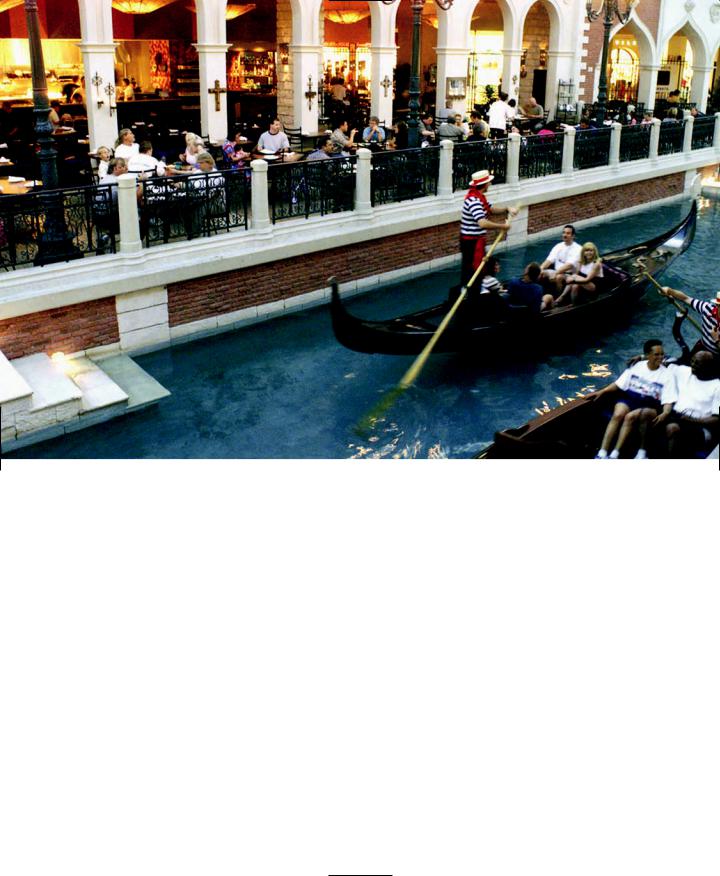
- •CONTENTS
- •PREFACE
- •Content—Benefits for Students
- •Content—Benefits for Instructors
- •Features of the Book for Students and Instructors
- •Supplementary Materials
- •Acknowledgments
- •What Is Hospitality Management?
- •The Manager’s Role in the Hospitality Industry
- •Why Study in a Hospitality Management Program?
- •Planning a Career
- •Employment as an Important Part of Your Education
- •Getting a Job
- •Employment at Graduation
- •The Outlook for Hospitality
- •Summary
- •Managing Change
- •Demand
- •Supply
- •Workforce Diversity
- •The Impact of Labor Scarcity
- •Summary
- •The Varied Field of Food Service
- •The Restaurant Business
- •The Dining Market and the Eating Market
- •Contemporary Popular-Priced Restaurants
- •Restaurants as Part of a Larger Business
- •Summary
- •Restaurant Operations
- •Making a Profit in Food Service Operations
- •Life in the Restaurant Business
- •Summary
- •Chain Restaurant Systems
- •Independent Restaurants
- •Franchised Restaurants
- •Summary
- •Competitive Conditions in Food Service
- •The Marketing Mix
- •Competition with Other Industries
- •Summary
- •Self-Operated Facilities
- •Managed-Services Companies
- •Business and Industry Food Service
- •College and University Food Service
- •Health Care Food Service
- •School and Community Food Service
- •Other Segments
- •Vending
- •Summary
- •Consumer Concerns
- •Food Service and the Environment
- •Technology
- •Summary
- •The Evolution of Lodging
- •Classifications of Hotel Properties
- •Types of Travelers
- •Anticipating Guest Needs in Providing Hospitality Service
- •Service, Service, Service
- •Summary
- •Major Functional Departments
- •The Rooms Side of the House
- •Hotel Food and Beverage Operations
- •Staff and Support Departments
- •Income and Expense Patterns and Control
- •Entry Ports and Careers
- •Summary
- •The Economics of the Hotel Business
- •Dimensions of the Hotel Investment Decision
- •Summary
- •The Conditions of Competition
- •The Marketing Mix in Lodging
- •Product in a Segmented Market
- •Price and Pricing Tactics
- •Place—and Places
- •Promotion: Marketing Communication
- •Summary
- •The Importance of Tourism
- •Travel Trends
- •The Economic Significance of Tourism
- •The United States as an International Tourist Attraction
- •Businesses Serving the Traveler
- •Noneconomic Effects of Tourism
- •Summary
- •Motives and Destinations
- •Mass-Market Tourism
- •Planned Play Environments
- •Casinos and Gaming
- •Urban Entertainment Centers
- •Temporary Attractions: Fairs and Festivals
- •Natural Environments
- •On a Lighter Note. . .
- •Summary
- •Management and Supervision
- •The Economizing Society
- •The Managerial Revolution
- •Management: A Dynamic Force in a Changing Industry
- •What Is Management?
- •Summary
- •Why Study Planning?
- •Planning in Organizations
- •Goal Setting
- •Planning in Operations
- •The Individual Worker as Planner
- •Long-Range Planning Tools
- •Summary
- •Authority: The Cement of Organizations
- •Departmentalization
- •Line and Staff
- •Issues in Organizing
- •Summary
- •Issues in Human-Resources Management
- •Fitting People to Jobs
- •Recruiting
- •Selection and Employment
- •Training
- •Retaining Employees
- •Staff Planning
- •Summary
- •The Importance of Control
- •Control and the “Cybernetic Loop”
- •Tools for Control
- •Summary
- •Leadership as Viewed by Social Scientists
- •Why People Follow
- •Leadership Theories
- •Communication
- •The Elements of Leading and Directing
- •Developing Your Own Leadership Style
- •Summary
- •A Study of Service
- •Rendering Personal Service
- •Managing the Service Transaction
- •How Companies Organize for Service
- •Summary
- •INDEX

290Chapter 9 Lodging: Meeting Guest Needs
better serve this market segment including better lighting, easy-to-read instructions (clearly printed materials in larger fonts), and nonskid flooring materials, as well as employee training to heighten awareness of the older travelers’ needs.44
Women make 75 percent of all travel decisions. Female travelers account for almost 50 percent of all business travelers in the United States and the expectation is that they will outnumber male business travelers within the next ten years. In a survey of 13,000 female business travelers, the most important factors were close proximity to their clients (23 percent), followed by security of the lodging establishment (20 percent).45
Hotels are responding to this increase with more emphasis on personal service, secure electronic door locks, express check-in and check-out, a selection of good restaurants on the property, and free airport shuttle service. Some chains offer special services and amenities for women. For instance, market research at Westin indicated that women wanted irons, hair dryers, full-length mirrors, and coffeemakers in the guest rooms. Highquality makeup mirrors are now standard at Crown Plaza properties. Guest rooms at Ritz-Carlton hotels feature both skirt and pants hangers, spray starch, scented sachets, bath salts, bath gels, makeup remover pads, and detergent for washing delicate clothing. The Loews Vanderbilt Plaza Hotel in Nashville has found gender-specific amenities to be very popular with guests. Whereas men might find cigars and a bottle of red wine in their room, women are more likely to find fresh flowers, fruit, candy, or white wine.46
Finally, families also represent a significant market. Although the percentage of U.S. households that are married with children is small (24 percent), new travel niches include travel with extended family members as well as travel by the nontraditional family. Multigenerational family travel, also referred to as grandtravel, has increased. About one-third of all leisure travelers are grandparents, and one-third of these took at least one vacation with their grandchildren last year. Hotels are correspondingly finding ways to compete for these young guests with features such as free-stay programs, children’s menus in the restaurants and room service, pools, and in-room video games. Families are increasingly interested in emerging lodging alternatives such as condominium resorts and vacation ownership. There has also been a marked increase in families wanting participative programs for the entire family, allowing them to discover new things together, versus the more traditional “supervisory” programs for children only.47
Service, Service, Service
Whether a limited-service economy hotel property or one in the upper echelons of the luxury segment, each and every lodging establishment has the opportunity to deliver quality service. Quality service is service that “consistently meets and exceeds customer expectations.”48 Exceeding customer expectations results in a perception of

Service is an increasingly important dimension in all categories of hotels. (Courtesy of Las Vegas Convention and Visitors Authority.)
high-quality service. Failing to meet expectations results in the customer’s perception of quality being relatively low. Since service is perception-based, the true measurement rests with the individual customer.
There are, however, a number of hotel ratings and measures that are based on a variety of perceptions, from guest surveys to rating-service inspectors. The ratings assigned by the Mobil Travel Guides and the American Automobile Association (AAA) are the best known in North America, but rating services also abound internationally. Hotels are rated on a multitude of criteria, including guest rooms, amenities, recreational facilities, decor and furnishings, public areas, housekeeping standards, restaurant operations including room service, and the maintenance of grounds and landscaping. The service-orientation and professionalism of hotel staff members, however, are foremost and include both the ability of employees to meet guests’ needs through their knowledge and interpersonal skills and the employees’ professional attire and grooming. Industry Practice Note 9.5 discusses the rating services further, both in the United States and abroad, providing a list of sample criteria used by one of the rating services and describing some of the world’s most luxurious and exclusive hotels.
291

INDUSTRY PRACTICE NOTE 9.5
Hotel Rating Services
The Mobil Travel Guides offer a one-star to five-star rating system for hotels, motels, inns, resorts, and restaurants in more than 3,000 towns and cities in the United States and Canada. For 2006, five stars were awarded to an elite group of 34 lodging establishments. Stars can also be taken away from properties because of perceived lower quality in service and facilities. Based on on-site visits and inspections, some of which are unannounced until after the hotel stay, these ratings are considered extremely important in the hotel industry and are used extensively in advertising and other sales and marketing activities. Table 1 lists five-star hotels for 2006.1 Table 2 presents several categories evaluated by Mobil in its expectations of a five-star lodging property.2
TABLE 1
2006 Mobil Travel Guide Five-Star Awards (by state)
CALIFORNIA |
|
The Beverly Hills Hotel, Beverly Hills |
The Peninsula, Beverly Hills |
|
|
Raffles L’Ermitage Beverly Hills |
Hotel Bel-Air, Los Angeles |
|
|
St. Regis Resort, Monarch Beach |
Chateau du Sureau, Oakhurst |
|
|
Four Seasons Hotel, San Francisco |
The Ritz-Carlton, San Francisco |
|
|
St. Regis Hotel, San Francisco |
|
|
|
|
|
COLORADO |
|
The Little Nell, Aspen |
The Broadmoor Resort, Colorado Springs |
|
|
|
|
CONNECTICUT |
|
The Mayflower Inn, Washington |
|
|
|
|
|
DISTRICT OF COLUMBIA |
|
The Four Seasons Hotel, Washington, DC |
|
|
|
|
|
FLORIDA |
|
Four Seasons Resort, Palm Beach |
The Ritz-Carlton, Naples |
|
|
|
|
GEORGIA |
|
Four Seasons Hotel, Atlanta |
The Lodge at Sea Island Golf Club, Sea Island |
|
|
|
|
HAWAII |
|
Four Seasons Resort Maui at Wailea |
|
|
|
|
|
ILLINOIS |
|
Four Seasons Hotel, Chicago |
The Peninsula, Chicago |
|
|
The Ritz-Carlton Chicago, A Four Seasons Hotel |
|
|
|
|
|
MASSACHUSETTS |
|
Blantyre, Lenox |
Four Seasons Hotel, Boston |

NEVADA
The Tower Suites at Wynn Las Vegas
NEW YORK |
|
The Point, Saranac Lake |
The Ritz-Carlton New York, Central Park |
|
|
Four Seasons Hotel, Manhattan |
Mandarin Oriental, New York |
|
|
|
|
NORTH CAROLINA |
|
The Fearrington House Country Inn, Pittsboro |
|
|
|
|
|
SOUTH CAROLINA |
|
Woodlands Resort & Inn, Summerville |
|
|
|
|
|
TENNESSEE |
|
The Hermitage Hotel, Nashville |
|
|
|
|
|
TEXAS |
|
The Mansion on Turtle Creek, Dallas |
|
|
|
VIRGINIA
The Inn at Little Washington, Washington |
The Jefferson, Richmond |
TABLE 2
Sample Criteria for the Mobil Five-Star Designation
MOBIL TRAVEL GUIDE RATING CRITERIA EXPECTATIONS OF A FIVE-STAR PROPERTY
Guest arrival phase: |
Reservationist uses the guest’s name throughout the conversation, thanks |
|
guest, and asks if there are any other needs. Background noise is limited. |
|
Guest name is used upon arrival at the hotel; guest key and credit card are |
|
placed in the guest’s hand. Calls to desk ring no more than three times. A |
|
full explanation of the property is given at check-in or by bell staff. All |
|
guests are escorted to guest rooms. Guest rooms are prepped in advance. |
|
|
Inspection of guest room: |
Room has a sense of elegance, with quality products. The following amenities |
|
are available: fax, video, VCR, Internet connectivity, cell phones, in-room games. |
|
Telephones throughout the property should be answered within three rings. |
|
|
|
The guest’s name is used, and wake-up calls arrive within five minutes of |
|
the requested time. Greetings should be friendly. |
|
|
|
Ice bucket is filled at turn-down, and a complimentary shoeshine is avail- |
|
able. Housekeeping is impeccable. Staff is able to accommodate specific |
|
requests for time of service. Floors and counters are likely marble. Robes |
|
and towels are plush and large. |
|
|
Food and beverage: |
At least two full-service restaurants and cocktail lounges are available. One |
|
restaurant should achieve at least a four-star rating. Room service should |
|
be available 24 hours a day, with the ability to cater to almost any culinary |
|
request. Banquet and catering facilities are expected to be world-class. |
Continues on next page

The American Automobile Association rates lodging properties based on a system of one to five diamonds. More than 57,000 properties are evaluated by AAA each year and less than one-half of 1 percent (0.26 percent) attain five-diamond status. Each property undergoes an unannounced evaluation, and properties receiving a five-diamond rating for the first time generally are reviewed at least twice. AAA also evaluates restaurants, campgrounds, attractions and events.
Zagat publishes ratings of U.S. hotels, resorts, and spas based on ratings and reviews from over 20,000 frequent travelers. Their categories of awards include “Top Hotel Chain,” “Best Hotel,” “Best Resort,” “Best Small Property,” and “Best Spa.” Conde Nast Traveler publishes a Gold List based on a poll of approximately 37,000 readers. Hotels are rated based on rooms, service, restaurants, location, atmosphere, and activities. Added to the list of hotel ratings and awards are Travel Leisure’s World’s Best Hotels, the Robb Report’s Best Luxury Hotels, and Corporate Meetings & Incentives’ Paragon Awards.
Hotel ratings in other parts of the world come from a variety of sources, if they exist at all. The government takes the role of hotel rater in some areas, whereas in others, it is tourism groups or the operators themselves. Examples of the variance in hotel rating systems abound within and among countries.3
For instance:
■In the United Kingdom, the Automobile Association, Royal Auto Club, and English Tourism Council have adopted a standardized rating system for member properties. The criteria include cleanliness and housekeeping, service and hospitality, guest rooms, bathrooms, food quality and service, public rooms, safety and security, and exterior and interior appearance and upkeep. A oneto five-star rating system is used, with five-star hotels considered among the best in the industry.
■In France, hotels display the federal government-sanctioned star rating, ranging from one to four stars. Only four-star hotels are guaranteed to have adequate service and facilities for the typical meeting planner. A number of hotels, however, have opted to take lower ratings than four stars for tax reasons.
■In Germany and some Scandinavian countries, a oneto five-star system exists. By law, hotels can only promote these ratings for three years before the government requires a new inspection.
■Regarding overall hotel standardization in Europe, about 70 percent of hotels are independently operated. Internal criteria from chains may therefore be lacking in establishing standards for everything from room cleanliness to service basics.
■The respective country’s ministry of tourism rates hotels across Latin America. Upon opening, hotels are inspected and granted from zero to five stars. Some hotels actually engage in rating themselves, thereby demeaning the star system and even, in some cases, going as high as seven stars. The other problem faced is that the governmental ratings are given for an indefinite period, even sticking for the life of the hotel, regardless of declining quality.
■In Asia, there tends to be no common rating system. Probably the most widely accepted rating system is the Institutional Investor system. This limited system only designates which hotels are world-class
294

properties. In China, the government ranks hotels using the star system, with five stars being comparable to international luxury hotels. In Hong Kong, hotels are divided into three categories: high tariff, medium tariff, and hostels or guesthouses. In this country’s rating system, price tends to be the most accurate indication of quality.3
What Are Some of the “Best of the Best” Hotels?
Although the list of the world’s finest hotels varies depending on the source and time, there are a number of lodging properties that are well known for providing the ultimate in luxurious service and surroundings. As would be expected, these hotels attract some of the world’s most exclusive guests, who readily pay top room rates for their pampered environment. Listed below are just a few examples of some of the “best of the best” in showcasing luxury suites in some of the world’s best hotels:
Atlantis, The Bahamas
The Bridge Suite in Atlantis is one of the world’s most expensive hotel suites. At $25,000 a night, guests enjoy a spectacular view from the suite, which is suspended between the two vast Atlantis Royal Towers. The master bedroom contains a spacious lounge area and a ten-foot four-poster bed. Hand-painted linens adorn the bed, and guests enjoy wardrobes the size of a garage. There is also the added comfort and convenience of round-the-clock butler and housekeeping service.
Burj Al Arab, Dubai, United Arab Emirates
At 1,053 feet, which is taller than the Eiffel Tower and only slightly shorter (60 meters) than the Empire State Building, the Burj is the tallest hotel in the world. The hotel is built on top of a man-made island, with only a bridge linking it to land. The toll for crossing the bridge is $50, which is just a mere fraction of the typical suite room rate of almost $7,000 per night. The hotel contains the world’s fastest elevators and has been crafted from more than 96,000 square feet of gold leaf, marble, and crystal. The hotel has a dramatic view of the surrounding ocean. A submarine ride takes guests to an underwater restaurant containing a shark-infested aquarium. Other luxuries include a private screening room, rotating beds, private elevators, and a helipad. There are private butlers to give the ultimate in personal service. In addition, guests are provided with laptop computers to use during their stay.
The Fairmont, San Francisco
The Penthouse Suite, which spans the entire eighth floor of the Fairmont, typically rents in the range of $10,000 per night. The suite features three large bedrooms, a living room with a grand piano, an eat-in kitchen, a billiard room, and a view of San Francisco and the bay. The suite also contains a two-story circular library and a dining room that can seat 50 people. In addition to the customary personal services of private butlers and housekeepers, guests staying in the Penthouse Suite also have their choice of a Porsche 911, Cayenne, or Boxster to drive during their visit.
1.Mobil Rating Service, www.mobil.com
2.Auto Club South, “Club News: 2006 Five Diamond Awards,” www.aaasouth.com/acs_news/5diamond03.asp
3.Megan Rowe, “Sorting Out Overseas Hotel Ratings,” Religious Conference Manager, February 1, 2003, rcm.meetingsnet.com. Source: www.mobiltravelguide.com and Asian Hospitality (December 2002), “Checking out the world’s finest,” 1(4), pp. 9–11.
295
